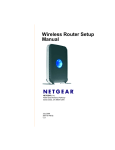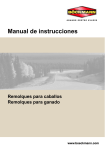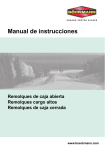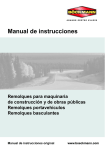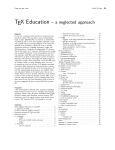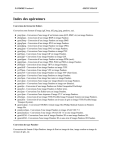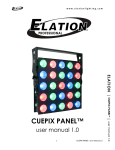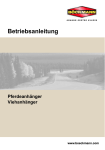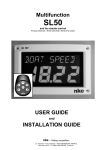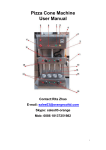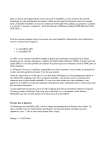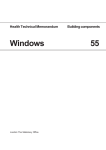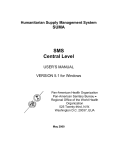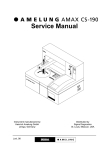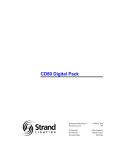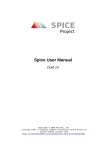Download Operating Instructions - Böckmann Fahrzeugwerke GmbH
Transcript
Operating Instructions Horse Trailer Livestock Trailer www.boeckmann.com Operating Instructions 04/13 Horse Trailer, Livestock Trailer Your vehicle data Vehicle model: Chassis no.: Total weight rating: Year of construction: Tyre size/manufacturer: Overrun device typeProducer / test mark: Drawbar / tow bar Manufacturer / test symbol: Axle type Manufacturer / test symbol: Wheel brake type Manufacturer / test symbol: Ball coupling type Manufacturer / test symbol: Key no. for lockable coupling: Copyright BÖCKMANN Fahrzeugwerke GmbH retains all rights to these operating instructions as well as translations of these operating instructions. The technical information contained therein may not be reproduced in whole or in part in any form whatsoever (including printout, photocopy, microfilm or data transfer) without the written permission of BÖCKMANN Fahrzeugwerke GmbH. Storage, processing, duplication and distribution by electronic means and circulation to third parties are prohibited. 04/13 Operating Instructions 04/13 Horse Trailer, Livestock Trailer Table of contents 1 Important Information . . . . . . . . . . . . . . . . . . . . . . . . . . . . . . . . . . . . . . 1 1.1 1.2 1.3 1.4 1.5 1.6 Operating Instructions . . . . . . . . . . . . . . . . . . . . . . . . . . . . . . . . . . . . . . . . . . . . . Representation Conventions . . . . . . . . . . . . . . . . . . . . . . . . . . . . . . . . . . . . . . . . Trailer Versions and Accessories . . . . . . . . . . . . . . . . . . . . . . . . . . . . . . . . . . . . Third-Party Documentation . . . . . . . . . . . . . . . . . . . . . . . . . . . . . . . . . . . . . . . . . Trailer Approval . . . . . . . . . . . . . . . . . . . . . . . . . . . . . . . . . . . . . . . . . . . . . . . . . . Driving Licence . . . . . . . . . . . . . . . . . . . . . . . . . . . . . . . . . . . . . . . . . . . . . . . . . . 1 1 2 2 2 2 2 Safety . . . . . . . . . . . . . . . . . . . . . . . . . . . . . . . . . . . . . . . . . . . . . . . . . . . 3 2.1 2.2 2.3 2.4 Intended Use . . . . . . . . . . . . . . . . . . . . . . . . . . . . . . . . . . . . . . . . . . . . . . . . . . . . Basic Safety Instructions . . . . . . . . . . . . . . . . . . . . . . . . . . . . . . . . . . . . . . . . . . . Labels . . . . . . . . . . . . . . . . . . . . . . . . . . . . . . . . . . . . . . . . . . . . . . . . . . . . . . . . . Disposal . . . . . . . . . . . . . . . . . . . . . . . . . . . . . . . . . . . . . . . . . . . . . . . . . . . . . . . . 3 Technical Data . . . . . . . . . . . . . . . . . . . . . . . . . . . . . . . . . . . . . . . . . . . . 7 3.1 Rating plate . . . . . . . . . . . . . . . . . . . . . . . . . . . . . . . . . . . . . . . . . . . . . . . . . . . . . 7 4 Trailer Features . . . . . . . . . . . . . . . . . . . . . . . . . . . . . . . . . . . . . . . . . . . 8 4.1 4.2 4.3 4.4 4.5 4.6 4.7 4.8 4.9 4.10 4.11 Electrical Connections . . . . . . . . . . . . . . . . . . . . . . . . . . . . . . . . . . . . . . . . . . . . . 8 Towing Devices . . . . . . . . . . . . . . . . . . . . . . . . . . . . . . . . . . . . . . . . . . . . . . . . . . 9 Coupling. . . . . . . . . . . . . . . . . . . . . . . . . . . . . . . . . . . . . . . . . . . . . . . . . . . . . . . 10 Breakaway Cable for Overrun Brake . . . . . . . . . . . . . . . . . . . . . . . . . . . . . . . . . 11 Jockey wheel . . . . . . . . . . . . . . . . . . . . . . . . . . . . . . . . . . . . . . . . . . . . . . . . . . . 11 Parking brake and wheel chocks . . . . . . . . . . . . . . . . . . . . . . . . . . . . . . . . . . . . 12 Support leg. . . . . . . . . . . . . . . . . . . . . . . . . . . . . . . . . . . . . . . . . . . . . . . . . . . . . 14 Rear Ramp Top Canvas Cover . . . . . . . . . . . . . . . . . . . . . . . . . . . . . . . . . . . . . 14 Rear ramp/1-section door combination . . . . . . . . . . . . . . . . . . . . . . . . . . . . . . . 15 Safety Stall Bar System . . . . . . . . . . . . . . . . . . . . . . . . . . . . . . . . . . . . . . . . . . . 16 Breech bars . . . . . . . . . . . . . . . . . . . . . . . . . . . . . . . . . . . . . . . . . . . . . . . . . . . . 16 5 Coupling . . . . . . . . . . . . . . . . . . . . . . . . . . . . . . . . . . . . . . . . . . . . . . . . 17 5.1 5.2 5.3 Nose Weight . . . . . . . . . . . . . . . . . . . . . . . . . . . . . . . . . . . . . . . . . . . . . . . . . . . 17 Coupling. . . . . . . . . . . . . . . . . . . . . . . . . . . . . . . . . . . . . . . . . . . . . . . . . . . . . . . 17 Parking the Trailer . . . . . . . . . . . . . . . . . . . . . . . . . . . . . . . . . . . . . . . . . . . . . . . 18 04/13 3 3 4 6 Operating Instructions Table of contents 6 Loading . . . . . . . . . . . . . . . . . . . . . . . . . . . . . . . . . . . . . . . . . . . . . . . . 19 6.1 6.2 6.3 6.4 6.5 Loading and Unloading the Trailer . . . . . . . . . . . . . . . . . . . . . . . . . . . . . . . . . . . Preparations . . . . . . . . . . . . . . . . . . . . . . . . . . . . . . . . . . . . . . . . . . . . . . . . . . . . Weight Distribution . . . . . . . . . . . . . . . . . . . . . . . . . . . . . . . . . . . . . . . . . . . . . . . Securing Animals for Transport . . . . . . . . . . . . . . . . . . . . . . . . . . . . . . . . . . . . . Loading Animals Safely . . . . . . . . . . . . . . . . . . . . . . . . . . . . . . . . . . . . . . . . . . . 7 Driving . . . . . . . . . . . . . . . . . . . . . . . . . . . . . . . . . . . . . . . . . . . . . . . . . 23 7.1 7.2 7.3 7.4 7.5 Pre-drive Checklist . . . . . . . . . . . . . . . . . . . . . . . . . . . . . . . . . . . . . . . . . . . . . . . Driving Precautions . . . . . . . . . . . . . . . . . . . . . . . . . . . . . . . . . . . . . . . . . . . . . . Brakes . . . . . . . . . . . . . . . . . . . . . . . . . . . . . . . . . . . . . . . . . . . . . . . . . . . . . . . . Reversing . . . . . . . . . . . . . . . . . . . . . . . . . . . . . . . . . . . . . . . . . . . . . . . . . . . . . . Manoeuvring . . . . . . . . . . . . . . . . . . . . . . . . . . . . . . . . . . . . . . . . . . . . . . . . . . . 8 Cleaning, Maintenance and Inspection. . . . . . . . . . . . . . . . . . . . . . . 27 8.1 8.2 8.3 8.4 Care and Cleaning . . . . . . . . . . . . . . . . . . . . . . . . . . . . . . . . . . . . . . . . . . . . . . . Maintenance. . . . . . . . . . . . . . . . . . . . . . . . . . . . . . . . . . . . . . . . . . . . . . . . . . . . Tyres and Changing Wheels . . . . . . . . . . . . . . . . . . . . . . . . . . . . . . . . . . . . . . . Inspection . . . . . . . . . . . . . . . . . . . . . . . . . . . . . . . . . . . . . . . . . . . . . . . . . . . . . . 9 Troubleshooting . . . . . . . . . . . . . . . . . . . . . . . . . . . . . . . . . . . . . . . . . 37 10 Service . . . . . . . . . . . . . . . . . . . . . . . . . . . . . . . . . . . . . . . . . . . . . . . . . 38 19 19 19 20 21 23 24 25 26 26 27 28 29 30 10.1 Information on Quality . . . . . . . . . . . . . . . . . . . . . . . . . . . . . . . . . . . . . . . . . . . . 38 10.2 Ordering Spare Parts and Accessories . . . . . . . . . . . . . . . . . . . . . . . . . . . . . . . 39 04/13 Horse Trailer, Livestock Trailer 1 Important Information 1 Important Information 1.2 Representation Conventions Dear Customer, 1.2.1 Safety Notices and Warnings These operating instructions are intended to help you use your "First-Class Trailer" optimally. Following these instructions will ensure that you can use your trailer safely for a long time. In these operating instructions a threelevel system is used to indicate different hazard severities. This trailer has been developed and designed to the latest state-of-the-art and has been thoroughly tested to ensure perfect functioning prior to despatch. Indicates that death or serious bodily injury will probably occur if the specified precautionary measures are not taken. 1.1 Operating Instructions – Please retain these operating instructions for future reference. If you sell or lend your trailer to a third party please always give the operating instructions to the new user. – Please read the operating instructions completely before using the trailer for the first time. – Disregard of these operating instructions may lead to injuries or damage to the trailer. – BÖCKMANN accepts no liability for damage resulting from disregard of these operating instructions. Indicates that minor to moderate bodily injury will occur if the specified precautionary measures are not taken. Indicates that material damage will occur if the specified precautionary measures are not taken. The following markings are also used: NOTE Points out particularly important information about the trailer, handling of the vehicle or the respective part of the operating instructions. TIP Indicates a user tip. 04/13 1 Operating Instructions Important Information 1 1.2.2 Text Distinctions The following text markings are used in these operating instructions: A Version variants are indicated by the respective capital letters. 1.3 Trailer Versions and Accessories All trailers are available in different versions. You can also retrofit your trailer with additional accessories (see "Spare Parts and Accessories"). Due to the large number of versions and accessory parts, not all trailer versions are described. Familiarise yourself with the version, options and accessories of your trailer to identify the corresponding version variants in these operating instructions that apply to your trailer. 1.4 Third-Party Documentation If the trailer is fitted with purchased parts the corresponding operating instructions from the third-party manufacturers are supplied with the trailer documents. Please heed the information regarding operation, maintenance and care of the purchased part in the corresponding operating instructions. 1.5 Trailer Approval Trailer approval is country-specific. Please find out how and where you can obtain approval for your trailer. The following applies in Germany: You must insure your trailer and obtain approval for road driving before you can drive on the roads. 1.5.1 Speed Limit of 100 The maximum allowable speed for towing the trailer is 80 kph. If certain requirements are met the speed limit can be raised to 100 kph by the approval authority. NOTE For detailed information on the requirements please see "Böckmann Info" on the website www.boeckmann.com. 1.5.2 Vehicle Inspection The regulations for vehicle inspections are country-specific. Please find out – when a vehicle inspection is required and – where a vehicle inspection can be carried out for your vehicle. 1.6 Driving Licence Depending on the country, a specific driving licence may be needed for towing a trailer. Please find out about the requirements in your country. 2 04/13 Horse Trailer, Livestock Trailer 2 Safety 2 Safety 2.1 Intended Use The trailer is designed to transport animals and packaged goods in the range of the corresponding gross weight rating (see "Technical Data"). Any other use is considered to be improper use. BÖCKMANN accepts no liability for damage resulting from improper use. The following uses are prohibited: – transport of people – transport of dry bulk goods. 2.2 Basic Safety Instructions 2.2.1 Inspections – Inspections may only be carried out at BÖCKMANN-approved authorised shops. For further information please go to www.boeckmann.com. – The delivery inspection must be carried out by the dealer and recorded in the inspection schedule (see "Cleaning, Maintenance and Inspection"). 2.2.2 People – Trailers are not toys. Do not allow children to play unattended in the vicinity of a trailer. They may injure themselves when playing with the trailer. – People working with or driving the trailer must have read and understood these operating instructions. 2.2.3 Trailer – Never use a defective trailer. Defective trailers conceal unforeseeable risks. – The rear lights of the trailer must be visible at all times. If the rear lights are covered by a protruding load, open ramps or dirt please mount an easily visible rear lighting unit to mark the end of the trailer. 2.2.4 Load – Do not exceed the total weight rating (see "Loading"). – The trailer must be loaded carefully and correctly. Incorrectly loaded trailers can easily start skidding. See "Loading" to find out how to load the trailer correctly. – The wheel bolts must be inspected after the first 50 km using a torque wrench (see "Cleaning, Maintenance and Inspection"). – All further inspections must be carried out in accordance with the inspection schedule (see "Cleaning, Maintenance and Inspection"). 04/13 3 Operating Instructions Safety 2 2.2.5 Transport of Coaches The following legal requirements apply to transport of coaches: – You may only transport a coach if the trailer is loaded. Ensure that the maximum allowable nose weight is not exceeded by the additional weight of the coach. – If you use the trailer without transporting a coach the nose weight must be at least 25 kg. – Before driving on public roads you must adequately secure the loaded coach. Cover all protruding parts and sharp edges. 2.2.6 Driving – Before starting a journey you must complete the pre-drive checklist (see "Driving"). – Familiarise yourself with the driving and braking characteristics (see "Driving") of the trailer in difficult road and weather conditions, for example inclines, rough roads, storms, side wind and snow. – Repairs may only be carried out at BÖCKMANN-approved authorised shops. – Only genuine BÖCKMANN spare parts may be used for repair. – Vehicle modifications and extensions are subject to the approval of BÖCKMANN. 2.2.8 Environmental Conditions – Protect the trailer and accessories as well as possible from adverse weather conditions such as rain, snow and hail. – Ensure adequate lighting when working on the trailer at dusk or in the dark. 2.3 Labels The following labels are affixed to the trailer: 2.3.1 Read Operating Instructions – Your driving behaviour and speed must always be adapted to the given road and weather conditions. – At all times during the journey you must be able to see the road behind you through the two exterior mirrors. Fig. 1: 2.2.7 Repair Please note the following for repairs: 4 "Read instructions" label This indicates that you should read the operating instructions before using the trailer. 04/13 Horse Trailer, Livestock Trailer 2 Safety 2.3.2 Replace Spring Clip 2.3.4 Removing the safety bar PANIC SYSTEM Fig. 2: "Lock using spring clip" label This indicates that you may only use locks with spring clips. Fig. 4: "Removing the safety bar" label Indicates how to remove the safety bar system in case of an emergency. If a spring clip is missing from a lock you must immediately replace the spring clip. 2.3.3 Lubrication Points on the Coupling Fig. 3: "Lubrication points on coupling" label This indicates the places where you must lubricate the coupling. 04/13 5 Operating Instructions Safety 2 2.4 Disposal The trailer owner must dispose of the trailer and all associated components in accordance with national disposal regulations. Waste electrical and electronic equipment Devices marked with this symbol are subject to the European Directive 2002/96/EG. All old electronic and electric devices must be disposed of separately from normal house waste. Ask your local authority how to properly dispose of old devices. Batteries Batteries may contact toxic heavy metals and must be treated as hazardous waste. Dispose of old batteries at the appropriate collection point. Hydraulic oil Hydraulic oil must be disposed of properly. Please observe local regulations. Old tyres Dispose of old tyres in accordance with local regulations. 6 04/13 Horse Trailer, Livestock Trailer 3 Technical Data 3 Technical Data The technical data for your trailer can be found in the following places: – in the vehicle documents for your trailer – on the trailer's rating plate – in the type identification information for the trailer. 3.1 Rating plate 1 2 3 XX XXXX XX XXXX XX XXXXXXXXXXXXXXXXX 4 XXXX 5 XXXX 12- Fig. 1: 6 XXXX kg kg kg Rating plate 1 Manufacturer 2 General operator's licence (ABE) number for the approved trailer type 3 17-digit trailer identification number 4 Total weight rating 5 Total weight rating for axle 1 6 Total weight rating for axle 2 (if applicable) 04/13 7 Operating Instructions Trailer Features 4 4 Trailer Features 4.1 Electrical Connections The following connectors are distinguished: Fig. 1: Plug versions – 7-pin connector – 13-pin connector. NOTE Please use an adapter if the socket of the towing vehicle does not match the trailer plug. Contact no. Function Connected load Wire colour 1 Direction indicator left (flash light) 1.5 mm2 yellow 2 a) Rear fog light 1.5 mm2 blue mm2 white 3 Ground for contacts no. 1 to 8 2.5 4 Direction indicator right (flash light) 1.5 mm2 green mm2 brown 5 Right-hand tail lights, outline marker lights, limiting lights and plate lightb) 1.5 6 Brake lights 1.5 mm2 red 2 black 7 Left-hand tail lights, outline marker 1.5 mm lights, limiting lights and plate lightb) 8 Reversing light 1.5 mm2 greyc) 9 Power supply (continuous positive) 2.5 mm2 brown/bluec) mm2 10 The power supply is controlled via the ignition 2.5 11a) Ground for circuit from contact no. 10 2.5 mm2 8 brown/redc) white/redc) 04/13 Horse Trailer, Livestock Trailer 4 Trailer Features Contact no. Function Connected load Wire colour 12 Reserved for future applications --- Not used 13a) Ground for circuit from contact no. 9 2.5 mm2 black/whitec) a) The three ground wires must not be connected to any functional electrical conductor on the trailer. b) The plate light must be connected in such a manner that no lamp of this device is connected with contacts no. 5 and 7. c) The colour assignment is determined by the manufacturer. Differences may occur. 4.2 Towing Devices C Drawbar for coach This version is a special model. The following towing devices are distinguished: – Standard drawbar (A), – Height-adjustable drawbar (B), – Drawbar for coach (C). A Standard drawbar This version is standard equipment. Incorrect load distribution Danger of Skidding • Adjust the breast and breech bars in the longitudinal direction of the trailer to achieve the correct nose weight through the different standing positions of the horses. B Height-adjustable drawbar NOTE See additional operating instructions and / or third-party documentation. Fig. 2: 04/13 Drawbar for coach 9 Operating Instructions Trailer Features 4 NOTE Coaches may only be transported on the drawbar if certain conditions are met (see "Safety"). Coupling status indicator 4.3 Coupling The following couplings are distinguished: – standard coupling version (A), Fig. 4: – anti-sway coupling (B) [accessory]. Check the wear indicator for the coupling. A Standard coupling version (also available lockable, A2) Wear indicator In coupled state, the indicator must lie within the "+" range. If the wear indicator is in the "–" range, do not drive with the trailer. The indicator shows the following statuses: A1 A2 – The "x" range indicates that the coupling is completely open. – The "+" range indicates that the coupling is seated correctly on the ball head. – The "–" range indicates that the coupling is not properly closed. Either the ball has not been fitted completely into the ball coupling or the ball coupling or ball is worn. Fig. 3: Standard coupling version A1 B Anti-sway coupling NOTE See additional operating instructions and / or third-party documentation. 10 Opening the coupling 1. Only for locking coupling: insert key and rotate until green semicircle is next to "OPEN". 04/13 Horse Trailer, Livestock Trailer 4 Trailer Features Fig. 5: Opened and closed coupling 2. Press and hold down the release button on the safety catch. 3. Pull the handle forward. Closing the coupling 1. Push the handle down. 2. Only for locking coupling: insert key and rotate until red semicircle is next to "OPEN". 4.4 Breakaway Cable for Overrun Brake NOTE The loop of the breakaway cable must be large enough to ensure that even in extreme curves the cable is not pulled and hence the trailer's emergency brake is not activated. Fitting the breakaway cable 1. Lay the breakaway cable over the tow bar on the towing vehicle. 2. Attach the clip to the breakaway cable. 4.5 Jockey wheel The trailer must be equipped with a jockey wheel for nose weights of 50 kg and higher. A jockey wheel can be retrofitted. NOTE Breakaway cables are only installed in braked trailers. Incorrectly loaded jockey wheel The jockey wheel is only intended to provide support. Do not manoeuvre a loaded trailer if the jockey wheel is lowered. The following jockey wheels are distinguished: – basic version of jockey wheel (A) – automatic jockey wheel basic version (B). Fig. 6: 04/13 Breakaway cable 11 Operating Instructions Trailer Features 4 A Basic version of jockey wheel Extending the jockey wheel 1. Only for the basic jockey wheel version: loosen the tommy screw and lower the jockey wheel. 2. Lower the jockey wheel using the hand crank. Retracting the jockey wheel 1. Raise the jockey wheel as far as possible using the hand crank. 2. Only for the basic jockey wheel version: slide the jockey wheel up as far as possible and tighten the tommy screw. 4.6 Parking brake and wheel chocks Fig. 7: Basic version of jockey wheel B Automatic jockey wheel basic version NOTE Parking brakes and wheel chocks can only be found on braked trailers. The following parking brakes are distinguished: – parking brake with spring energy accumulator (A) – parking brake with button and toothed segment (B). Sticking and frozen brake pads Personal injury through delayed braking action • Fig. 8: 12 Automatic jockey wheel The trailer should not be secured by means of the parking brake in frost conditions or when not in use for long periods. 04/13 Horse Trailer, Livestock Trailer 4 Trailer Features • Secure the trailer using wheel chocks. When the parking brake is applied, the trailer is secured against rolling. After applying the parking brake, the trailer can still be moved backwards approx. 25 cm. Only then does the full braking effect come into play. The forwards braking effect is immediately effective. • Ensure that the full braking power is applied. Applying the parking brake • Fig. 9: Positions of the wheel chocks A Parking brake with spring energy accumulator Pull the hand lever up until the braking action is applied. Releasing the parking brake • Push the hand lever down. B Parking brake with button and toothed segment Fig. 10: Parking brake with spring energy accumulator Delayed braking action with the spring energy accumulator Fig. 11: Parking brake with button and toothed segment Pinching of body parts, material damage 04/13 13 Operating Instructions Trailer Features 4 Applying the parking brake Extending the support leg • 1. Attach the hand crank to the support leg and crank until the leg is firmly touching the ground. Pull the hand lever up until the braking action is applied. Releasing the parking brake • Pull the hand lever up a bit further while simultaneously pressing the button to enable the hand lever to be lowered towards the front. 4.7 Support leg 2. Detach the hand crank and store safely. Retracting the support leg 1. Attach the hand crank to the support leg and crank until the leg is completely retracted. 2. Detach the hand crank and store safely. 4.8 Rear Ramp Top Canvas Cover Fig. 12: Support leg Incorrectly used support leg Fig. 13: Canvas cover (roll-up) Pinching of body parts, material damage • Ensure optimum ventilation in the trailer in transit. • Close the canvas cover in wet or cold conditions to protect the horses from rain and draughts. • Only use the support leg to stabilise the trailer when parked. • Do not use as a car jack. • The tyres must always be loaded. 14 04/13 Horse Trailer, Livestock Trailer 4 Trailer Features 4.9 Rear ramp/1-section door combination B 1-section door NOTE This version is a special model for horse trailers. Horse trailers are each fitted with a combination door. This door can be used in two ways: – ramp (A) and – 1-section door (B). A Ramp Fig. 15: 1-section door Fully unlocked rear ramp/1-section door Death by crushing, pinching of body parts • Never release all latches at the same time. • Open either the lever for the rear ramp or the 1-section door. Fig. 14: Ramp This should be used to load and unload horses. Fig. 16: Incorrectly unlocked rear ramp/1section door 04/13 15 Operating Instructions Trailer Features 4 • Make sure there are only ever two latches open at the same time. 4.11 Breech bars 4.10 Safety Stall Bar System Fig. 18: Breech bars • Fig. 17: Safety Stall Bar System Secure the breech bars with the split pins prior to transport. If horses panic they may step over the breast bar in the trailer with their front legs. In such a case the breast bar can be released from the outside: • Unscrew the eye bolt on the outside. The bracket is released on the inside and swings down along with the breast bar. 16 04/13 Horse Trailer, Livestock Trailer 5 Coupling 5 Coupling 5.2 Coupling 5.1 Nose Weight Coupling must be done in a safe and well-lit location. The nose weight is defined as the weight on the towing device of the towing vehicle when a trailer is coupled. • Ensure that: – the nose weight is at least 4% of the actual laden weight of the trailer. However, it need not be more than 25 kg. – the maximum nose weight for the towing vehicle is not exceeded. The nose weight specifications are located with the towing vehicle: – on a label in the rear area, – in field 13 of part I (vehicle registration certificate) of the approval certificate. Danger of Skidding Bodily injury or material damage • Do not overload the trailer at the rear. • The load at the front of the trailer should be slightly higher than at the rear. The ground or support surface must be firm, strong and level. Traffic must not be restricted. Drivers and other people must not be hindered or endangered. Before hitching or unhitching secure the towing vehicle to prevent it rolling away. 5.2.1 Hitching the Trailer 1. Open the coupling completely. 2. Hitch the trailer. 3. Check that the coupling is firmly seated. The coupling's firm seating is indicated by the coupling statuses. Green or a "+" symbol indicate that the coupling is firmly seated. The colour red or a "-" symbol indicate that the coupling is not correctly engaged and secured. Coupling must be repeated. Correct seating must also be checked by pulling forcefully on the coupling. 4. Plug the trailer connector into the socket of the towing vehicle. 5. Attach the breakaway cable. 6. Retract the jockey wheel. 04/13 17 Operating Instructions Coupling 5 5.2.2 Unhitching the Trailer 1. Pull up the parking brake to prevent the trailer rolling away. 2. Remove the breakaway cable from the tow bar of the towing vehicle. 3. Lower the jockey wheel to unload the coupling. 4. Pull the plug out of the socket. 5. Open the coupling. 6. Lift the coupling up off the tow bar of the towing vehicle. 5.3 Parking the Trailer NOTE For the trailer to be stable the ground or support surface should be firm, level and flat. To park the trailer stably you must do the following (depending on the model): – lower the jockey wheel after unhitching, – place the wheel chocks under the tyres, – place the rear prop stands (if supplied) in position. 18 04/13 Horse Trailer, Livestock Trailer 6 Loading 6 Loading 6.1 Loading and Unloading the Trailer 6.3 Weight Distribution 6.3.1 Correct Load Distribution • The load must be uniformly distributed and form-fitting. For loading and unloading, the trailer must be coupled to a towing vehicle. • The weight must be concentrated at the axle(s). The ground or support surface must be firm, strong and level. Loading must be done in a safe and well-lit location. • Load the cargo in such a way that the centre of gravity is as low as possible. • The load must not protrude over the side wall. • Loose parts must be secured to prevent them slipping (see "Securing the Load"). • The minimum and maximum nose weight specifications must be complied with (see "Coupling"). Traffic must not be restricted. Drivers and other people must not be hindered or endangered. Additionally secure the trailer to prevent it rolling away: 1. Pull up the parking brake. 2. Place wheel chocks (if supplied) in front of the tyres. Correctly loaded trailer: 2 6.2 Preparations 1. Completely mount all required attachment parts before loading the trailer. Install parts which divide the load area (e.g. mesh partitions and similar parts) such that the load can be positioned in the middle near the axis. 1 2 Fig. 1: Zones for load distribution Fig. 2: Example of correct load distribution 2. Make sure all ramps, mesh partitions etc. are completely mounted and secured. 04/13 19 Operating Instructions Loading 6 6.3.2 Incorrect Load Distribution 6.4 Securing Animals for Transport Incorrect load distribution Material damage Unsecured loose parts • Injury to animals For measures for distributing the load correctly please see "Correct Load Distribution". • There must not be any loose parts, straps or slings in the load area. Incorrectly loaded trailer: Draughts Colds or conjunctivitis Fig. 3: Incorrect load distribution example A • Before starting a journey close all doors and window openings. • Secure the animals such that they will not be able to lose their balance or injure themselves even in extreme driving situations (full braking, swerving or similar actions). • Always tie large animals such as horses and cows on both sides. • Close, lock and secure all ramps, doors and sliding windows. • Completely fasten and secure safety bars, divider walls and mesh partitions. In example A the weight of the load is not on the axle. Fig. 4: Incorrect load distribution example B In example B the load is concentrated at the front of the trailer, making the nose weight on the tow bar of the towing vehicle too high. The rear of the towing vehicle is pulled down. Fig. 5: Incorrect load distribution example C In example C the load is concentrated at the rear of the trailer, making the leverage force on the tow bar of the towing vehicle too high. The rear of the towing vehicle is pulled up. The nose weight is too low. 20 Tip Use bandages to protect horses from bumps and injuries. 04/13 Horse Trailer, Livestock Trailer 6 Loading 6.5 Loading Animals Safely NOTE Please observe the following instructions for loading animals safely: – Switch on the interior light and open the front jockey door to light up the interior of the trailer as much as possible. NOTE An additional partition floor bracket [accessory] is required for driving with the partition in swung-out position. BÖCKMANN recommends use of a fullwidth stall bar [accessory] for a swivelled partition. Removing the partition – Make sure the rear ramp is positioned firmly and stably. 1. Swivel the partition at the rear to the left (when in the driving direction). – Adapt the safety breast bar to the height of the respective animal. 2. Lift the partition at the front out of the mount. – Swing the partition to the side to expand the horse area for anxious horses (see "Expanding the Load Area"). 6.5.2 Loading the Horse – The calmer the person leading the animal is, the more reassured the animal is. – For livestock trailers install the mesh partitions such that the animals are positioned in the middle of the trailer. 6.5.1 Expanding the Load Area Swivelling the partition 1. Lift the partition out of the recess at the rear and swing to the right (when in the driving direction). 2. Load the trailer. 3. Swing the partition back into its original position and secure. 1. Open the rear ramp and lower completely to the ground or support surface. 2. One person must be standing on the open side facing the trailer to steady the horse during loading. 3. Lead the horse on the rope straight and without hesitation on to the trailer. 4. Attach the stall bar and secure with the split pin. Stall bars with Multi Safe System (MSS) lock automatically after attaching. 5. Tie the rope to the tie ring at the front using a safety knot. NOTE BÖCKMANN recommends tying the horse on both sides. 04/13 21 Operating Instructions Loading 6 6. Close the rear ramp and secure both latches. • For large herds separate the animals into smaller groups using mesh partitions. 6.5.3 Unloading the Horse • Close and latch the mesh partition of the rear ramp. 1. Open the rear ramp from the side. The person involved must be standing beside the trailer. 4. Close and latch the rear ramp. 6.5.5 Unloading Livestock 2. Untie the rope. 3. Release the stall bar and swing down. 4. One person must be standing on the open side facing the trailer to steady the horse during unloading. 5. Back the horse slowly straight out of the trailer. 1. Open the rear ramp and lower completely to the ground or support surface. 2. Unloading livestock: A Large livestock • Untie the rope. 6.5.4 Loading Livestock • Release and open the mesh partition. 1. Open the rear ramp and lower completely to the ground or support surface. • One person must be standing on the open side facing the trailer to steady the animal during unloading. 2. One person must be standing on the open side facing the trailer to steady the livestock during loading. 3. Loading livestock: A Large livestock • Lead the animal on the rope straight and without hesitation on to the trailer. • Close and latch the mesh partition of the rear ramp. • Tie the rope to the tie ring at the front using a safety knot. • Back the animal slowly straight out of the trailer. B Small livestock • Open the inner mesh partitions (if used). • One person must be standing on the open side facing the trailer to steady the animals during unloading. • Release and open the mesh partition to let the animals out of the trailer. B Small livestock • Drive the animals on to the trailer. 22 04/13 Horse Trailer, Livestock Trailer 7 Driving 7 Driving 7.1 Pre-drive Checklist Component Check Windows and rear canvas cover Adjusted according to weather conditions? Tack room All objects secured against slipping? Doors and ramps Closed and secured? Animals Tied securely? Partition Fully engaged? Ball coupling Correctly engaged and secured? Breakaway cable Positioned over tow bar of towing vehicle? Parking brake Released? Connector Firmly connected and secured? Jockey wheel Fully raised and secured? Wheel chocks Removed and stored safely? Tyres Filled with the correct air pressure? Support legs Raised and secured? Crank removed and stored safely? Stall bars Attached and locked? Lighting system Undamaged and working? 04/13 23 Operating Instructions Driving 7 7.2 Driving Precautions Please read the following information carefully so that you are prepared for different driving conditions. 7.2.1 General Driving Precautions – The stability of the vehicle-trailer combination decreases with increasing speed. Adapt your speed to the given road and weather conditions to ensure that you can stop the vehicle and trailer without problems at any time. – Slow down while driving a loaded trailer on an incline to ensure that you can stop the vehicle and trailer without problems at any time. – Note that the turning radius of long trailers is unusually large. – Note that long trailers follow the vehicle in a smaller radius when turning. – If protruding or overhanging loads cover the lights you must attach an additional easily visible lighting unit. tics are poorer because the tyres have less traction. – Before making a trip remove any water, snow or ice from the roof of the trailer to avoid endangering other drivers. 7.2.3 Tips for Driving in Side Wind – Side wind can cause the trailer to snake or tip over. Side wind gusts often occur suddenly and unexpectedly, e.g. on rough terrain or bridges, when you are changing lanes or passing etc. Slow down immediately if you notice a side wind. 7.2.4 Tips for Handling Snaking – If the vehicle-trailer combination starts snaking carefully take your foot off the gas pedal and counter-steer gently. Do not speed up. Do not make any hectic or abrupt steering motions. – Trailer snaking may result if the tyre pressure is too low. Before making a trip check the air pressure in all tyres on the trailer. If necessary, adapt the tyre pressure to the weight of the load. 7.2.2 Tips for Driving in Rain, Frost and Snow – Note that on icy and slippery roads the driving and braking characteris- 24 04/13 Horse Trailer, Livestock Trailer 7 Driving 7.3 Brakes 7.3.1 Checking the Brake System The trailer's brake system must be checked regularly. Non-functioning brake system • Bodily injury or material damage Check whether: – the guides, Bowden cables or yokes are damaged or corroded, A poorly functioning or non-functioning brake system cannot promptly stop the trailer. – other components are restricting the Bowden cables, • Before each journey a brake test must be carried out with the trailer. – the joints on the yokes and the rods are free-moving, but secure, • Brake early. – the exteriors of the dust seals or gaskets are damaged. • Braking distance too short Bodily injury or material damage The braking distance of the trailer increases with increasing load. • Note that the ABS system of the towing vehicle does not control the overrun mechanism of the trailer. • The driver of the towing vehicle must initiate braking early. Ensure that any defects are repaired promptly. NOTE If the brake pads need to be replaced make sure the wheel bearings are also checked for wear and damage. NOTE For trailers with overrun brakes full braking may cause the overrun brake to block the wheels. brake the trailer first brake gently to avoid blocking the wheels. Then brake hard. TIP Inexperienced drivers should first practise braking without horses on suitable terrain. 04/13 25 Operating Instructions Driving 7 7.4 Reversing Blind spot Running over people or objects • Have an experienced person teach you how to reverse safely to ensure you will not endanger other drivers. • Make sure no one is between the towing vehicle and the trailer while reversing. • Instructors must maintain a safe distance to the trailer and must always be visible in the exterior mirrors when the trailer is being reversed. 7.5 Manoeuvring NOTE The trailer can be more easily manoeuvred if the air pressure in the tyres is not too low. If the trailer is difficult to manoeuvre check the tyre pressure (see "Tyre inflation pressure" table). 26 04/13 Horse Trailer, Livestock Trailer 8 Cleaning, Maintenance and Inspection 8 Cleaning, Maintenance and Inspection Cleaning, maintenance and inspection of the trailer are essential for driving safety as well as retention of the value of your trailer and the validity of your warranty. White rust White rust forms on zinc surfaces which are corroded by prolonged wetness or exposed to chlorides such as those found in road salt. White rust is not a galvanisation quality defect. A thin surface layer of white rust does not damage the galvanised layer. NOTE Late or skipped inspections or maintenance and cleaning work may result in damage to the trailer and consequent injury. This also voids the warranty. Brush off areas with heavy white rust formation using a nylon or wire brush and, if necessary, galvanise again. 8.1 Care and Cleaning Interiors of animal transporters You may carry out cleaning work yourself. NOTE All parts and surfaces must be checked for dirt and, if necessary, cleaned before and after use. This especially applies to transport of animals to ensure the hygiene and safety of the animals. Also, long-term dirt accumulation significantly affects driving safety and value retention. Salt and acids Avoid contact with salt, acids and caustic agents. After driving in road salt conditions or after transporting fertilisers or other acid-containing substances immediately clean the trailer inside and out with water. 04/13 Damage to galvanised layer Immediately galvanise again with a standard commercial zinc spray. Animal urine and excrement can attack the floor, rear ramp and seals and lead to corrosion. Hence take appropriate hygiene measures and thoroughly clean all dirty surfaces, seals between walls and the floor, anti-slip fittings, straps etc. after transport. Rubber floor The rubber floor is glued on and sealed around the edges along the side walls with a sealant. Protruding horseshoe nails and screwed-in or welded horseshoe studs can damage the rubber floor. Check the sealant regularly for damage and renew if damaged. The rubber floor can be protected with a scuff mat [accessory]. Canvas covers Canvases are easy-care products. Clean with soap and water. 27 Operating Instructions Cleaning, Maintenance and Inspection 8 Rear lights and lighting elements Rear lights and lighting elements must always be intact, unobstructed and clean. Wash or clean regularly. Rims, wheel guards and mudflaps Clean regularly. 8.2 Maintenance Maintenance work should only be carried out by suitably qualified personnel. Ensure that maintenance intervals are maintained. The maintenance intervals are given in the following table. Maintenance schedule Vehicle part Interval Maintenance work Tyres Before every long journey Check tyre pressures (see "Tyre inflation pressure" table) Check the tyre tread depth and exchange the tyres if necessary (note wear marks in the tyres' contact surfaces) Check wheel bolts and tighten if necessary (see "Tightening torques" table) Brake, bowden cables Every 5000 km or annually Lubricate lubrication points Parking brake Every 5000 km or annually Lubricate lubrication points Height-adjustable drawbar See additional operating instructions and / or third-party documentation. Coupling Regularly Clean Every 5000 km or annually Lubricate lubrication points Antirock coupling See additional operating instructions and / or third-party documentation. Lubricant Use a multipurpose grease in accordance with DIN 51825 KTA 3K for lubrication. 28 04/13 Horse Trailer, Livestock Trailer 8 Cleaning, Maintenance and Inspection 8.3 Tyres and Changing Wheels The trailer must be secured with wheel chocks or similar aids to prevent it rolling away. • Incorrectly repaired tyres Bodily injury or material damage • Only trained and qualified personnel may repair the tyres. • Do not repair tyres yourself. 8.3.1 Tread Depth According to the German Road Traffic Licensing Regulations (StVZO) the tread depth of the tyres must not be less than 1.6 mm. 8.3.2 Wheel Bearings The wheel bearings are maintenancefree. In severe loading conditions the wheel bearings must be checked for play. 8.3.3 Changing Wheels Rapidly lowering bed Death by crushing, serious bodily injury • Do not stand under the raised trailer. Wheel changing must be done in a safe and well-lit location. Traffic must not be restricted. Drivers and other people must not be hindered or endangered. 04/13 After changing wheels tighten wheel nuts to the correct torque (see "Tightening torques" table). 8.3.4 Wheel Bolts The tightness of the wheel bolts must be checked after the first 50 km. Also after a wheel change the wheel bolts must be checked after 50 km. The tightening torques for the wheel bolts are given in the following table. Tightening torques Rim type Tightening torque Steel 90 Nm to 100 Nm Aluminium 110 Nm 8.3.5 Tyre pressure If the tyre pressure is too low or too high it will have a negative effect on the handling of the vehicle-trailer combination, the fuel consumption and the life of the tyres. Regularly check the tyre pressure. The tyre inflation pressures are given in the following table. 29 Operating Instructions Cleaning, Maintenance and Inspection 8 Tyre inflation pressure Tyre size Tyre pressure at full load 18.5 x 8.50-6 3.4 bar 195/55 R10 C 6.25 bar 185/60 R12 C 6.4 bar 225/55 R12 C 5.3 bar 155 R 13 2.7 bar 185/70 R13 2.7 bar 195/50 R13 C 6.25 bar 185/65 R14 2.9 bar 195/70 R14 2.9 bar 185 R14 C 4.5 bar 195/65 R15 3.0 bar 8.4 Inspection Incorrect or missing inspection Danger of death, material damage • Inspections must be carried out by authorised specialist shops. • Work on brake systems as well as on electrical and hydraulic systems must be carried out according to the respective manufacturer's specifications. 30 04/13 Horse Trailer, Livestock Trailer 8 Cleaning, Maintenance and Inspection 8.4.1 Delivery Inspection Vehicle part Test criterion Work to be performed Brake system Braking effect Check and adjust if necessary Tyres Inflation pressure Check and adjust if necessary Lighting Lights Check and repair if necessary Wheels Wheel Bolts Check after 50 km (see "Wheel Bolts") Overrun brake Coupling Check after 100 km 8.4.2 First Inspection (at the latest 1000 km after delivery) Vehicle part Test criterion Work to be performed Overall trailer Screwed connection Check and tighten if necessary Corrosion protection, damage Check and touch up if necessary Tyres Inflation pressure Check and adjust if necessary Wheel Bearings Play Check and renew if necessary Brake system Braking effect Check and renew if necessary 04/13 31 Operating Instructions Cleaning, Maintenance and Inspection 8 8.4.3 Inspection Schedule Vehicle part Test criterion Work to be performed Brake system Brake pads Check and renew if necessary Brake mechanism Check and repair if necessary Friction points of the brake mechanism Grease Overrun mechanism Lubricate, check brake fluid Brake Adjust Seals check and replace bearing if necessary Play check and replace bearing if necessary Damage Carry out visual inspection and repair if necessary Mount Check and repair if necessary Rims Damage Check and renew if necessary Tyres Damage Check and renew if necessary Excessive ageing Check and renew if necessary Tread Check and renew if necessary Run-out Check and balance if necessary Wheel Bearings Axle Inflation pressure Check and correct if necessary Drawbar / overrun mechanism Screwed connections Check and replace if necessary Lighting Connectors, cables, lights Check and repair if necessary Reflectors and rear lights Check and renew if necessary Floor Damage Check and renew if necessary Rubber floor Sealing Check and renew if necessary Information signs Completeness and legibil- Check and renew if necessary ity Accessories Connections 32 Check and repair/renew if necessary 04/13 Horse Trailer, Livestock Trailer 8 Cleaning, Maintenance and Inspection 8.4.4 Inspection Verification Stamp Date Signature Delivery Inspection 1000 km inspection (max. ½ year after delivery) 5000 km inspection (max. ½ year after last inspection) 10,000 km inspection (max. ½ year after last inspection) 15,000 km inspection (max. ½ year after last inspection) 20,000 km inspection (max. ½ year after last inspection) 04/13 33 Operating Instructions Cleaning, Maintenance and Inspection 8 Stamp Date Signature 25,000 km inspection (max. ½ year after last inspection) 30,000 km inspection (max. ½ year after last inspection) 35,000 km inspection (max. ½ year after last inspection) 40,000 km inspection (max. ½ year after last inspection) 45,000 km inspection (max. ½ year after last inspection) 50,000 km inspection (max. ½ year after last inspection) 34 04/13 Horse Trailer, Livestock Trailer 8 Cleaning, Maintenance and Inspection Stamp Date Signature 55,000 km inspection (max. ½ year after last inspection) 60,000 km inspection (max. ½ year after last inspection) 65,000 km inspection (max. ½ year after last inspection) 70,000 km inspection (max. ½ year after last inspection) 75,000 km inspection (max. ½ year after last inspection) 80,000 km inspection (max. ½ year after last inspection) 04/13 35 Operating Instructions Cleaning, Maintenance and Inspection 8 Stamp Date Signature 85,000 km inspection (max. ½ year after last inspection) 90,000 km inspection (max. ½ year after last inspection) 95,000 km inspection (max. ½ year after last inspection) 100,000 km inspection (max. ½ year after last inspection) 36 04/13 Horse Trailer, Livestock Trailer 9 Troubleshooting 9 Troubleshooting Failure Possible cause Remedy Lighting does not work Connector not properly inserted into socket of towing vehicle Insert the plug all the way into the socket of the towing vehicle. Twist the 13-pin connector. Lamp defective Replace lamp. Cable defective Replace cable. Connector defective Replace connector. Object blocking side wall or rear ramp Open side wall or rear ramp, remove object and clean gap. Side wall or rear ramp warped Please contact your dealer or BÖCKMANN directly (see "Service"). Side wall or rear ramp cannot be closed 04/13 37 Operating Instructions Service 10 10 Service 10.1 Information on Quality The following are not defects: – Moisture, humidity – Water ingress, – Minor scratches – Varying surface appearance. Polyester components The polyester components are not 100% colour-fast; bleaching and/or colour changes may therefore occur. The individual components of a polyester construction may differ in colour and lustre. Fissures may also occur due to punctual strain on the components, e.g. hoof beats or sliding loads banging against the wall. Fissures are optical damages to the components. They do not affect the functioning or the safety of the vehicle. Moisture, humidity The trailer is not thermally insulated. Condensation may therefore form under tarpaulin covers or polyester and aluminium roofs. Water ingress Water may penetrate into the trailer through openings such as doors, ramps or windows. NOTE If your trailer is closed and parked for a long period make sure to ventilate the interior every now and again to prevent mildew from forming. Minor scratches In the manufacture of BÖCKMANN trailers care is taken to ensure that surfaces are not scratched. However, because the trailers are hand-built minor scratches can arise on the surfaces during assembly. These scratches do not affect the function or safety of the trailer and are not quality defects. 38 10.1.1 Varying surface appearance Wood surfaces All wood surfaces used are coated with phenolic resin or plastic. Both phenolic resin and plastic react to changing weather conditions. The colours may fade. Plywood walls and floors expand and contract minimally according to the relative humidity and temperature of the surrounding air due to the natural properties of the material. This may cause warpage in wood parts. Wood grains and unevenness may appear on the surface. Aluminium surfaces Aluminium extrusions are anodised. The colours of individual extrusions may vary slightly. This colouring is a characteristic of the material and does not affect the use or safety of the trailer. Rubber surfaces Due to their material properties rubber surfaces may shrink slightly over time. 04/13 Horse Trailer, Livestock Trailer 10 Service Galvanised metal surfaces Before galvanised metal surfaces can provide effective protection against corrosion they must oxide. This oxidation process may take some months. As long as the metal surface is still shiny silver the oxidation process is not yet completed. Galvanised parts are not resistant to certain aggressive chemical substances such as acids. Galvanised metal surfaces in contact with aggressive chemical substances (e.g. road salt in winter or fertiliser) must be rinsed thoroughly with clean water immediately after the journey. 10.2.1 Reordering Keys You can reorder keys for the following components: – lockable coupling – jockey door – tack room door – storage compartment door. XXXX 10.2 Ordering Spare Parts and Accessories There are two methods for ordering spare parts or accessories for your trailer: – You can contact the BÖCKMANN dealer in your region. Please see "Our Dealers" on the website www.boeckmann.com to find out where your nearest dealer is. When ordering please specify the engraved key number. The number is engraved on the key and the lock. – If there is no dealer in your area you can contact BÖCKMANN directly: BÖCKMANN Fahrzeugwerke GmbH Siehefeld 5 49688 LASTRUP GERMANY Tel: + 49 4472 895-210 or -680 Fax: +49 4472 895-470 Email: [email protected] 04/13 39 Operating Instructions 04/13 Horse Trailer, Livestock Trailer 04/13 Böckmann Fahrzeugwerke GmbH Siehefeld 5 49688 LASTRUP GERMANY Phone: + 49 4472 895-0 Fax: +49 4472 895-550 Email: [email protected] Art. no.: 1084223 www.boeckmann.com
















































